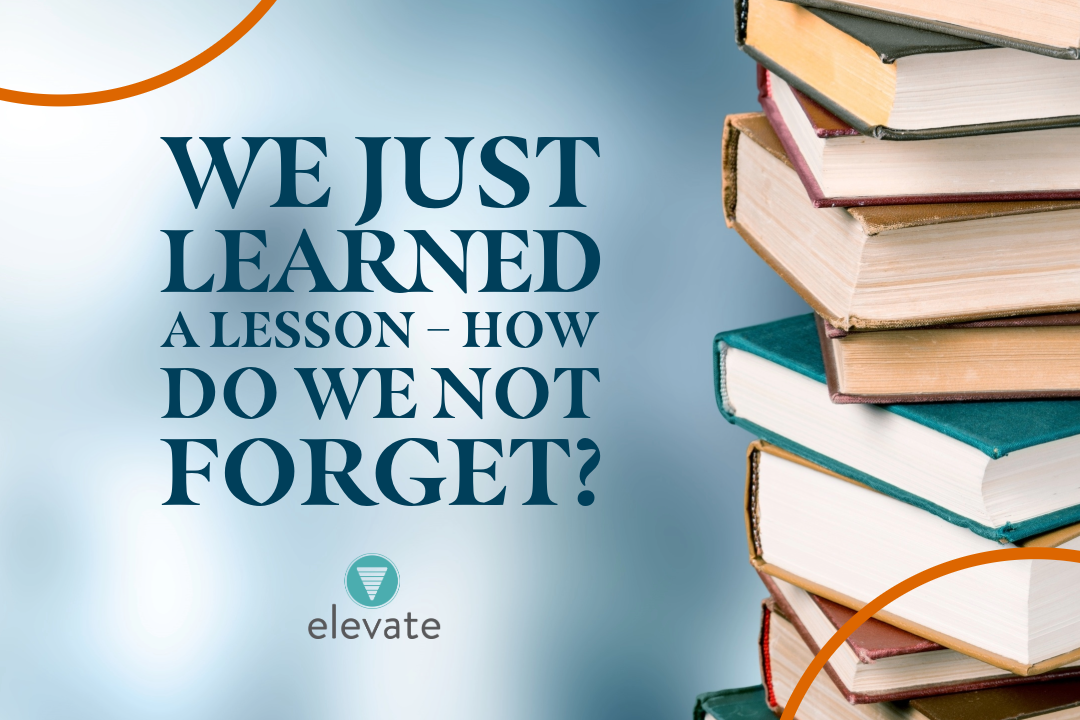We Just Learned a Lesson – How Do We Not Forget?
Written by Amy Merritt Campbell
While most of the thought around learning begins and ends in school, our ability and necessity to learn carries us through the rest of our lives. Because we are taught at such a young age to retain so much information, it can get tricky understanding what to keep and what to forget (I know I don’t remember a lot of the things I learned in school). As we grow and change, the necessity for a mental rolodex of dates, relationships, professional development information, songs, books, etc. increases while the proverbial room in our minds stays the same. How do we keep this information safe and readily accessible? How do we know what information is not necessary to keep on standby?
The same challenge exists at an organizational level. A true learning organization can compile, synthesize, reflect on, and use information efficiently – allowing it to adapt from past experiences as the context of the organization and its work changes. What can organizations do to develop learning practices that preserve institutional memory?
A helpful first step is understanding your team members’ learning styles. In 1987, Neil Fleming created the acronym VARK for the various learning styles, based on the idea set forward by Aristotle when talking about children and their individual skills and talents. VARK stands for visual, auditory, reading/writing (sometimes known as tactical), and kinesthetic.
· Visual learners retain information by seeing and observing, which makes them partial to infographics such as graphs, diagrams, pictures, timelines, etc.
· Auditory learners gravitate towards learning through listening. These learners will do better to listen and can even repeat the information back so that they can reinforce the content they’ve received.
· Learners who are partial to reading/writing will often take extensive notes, both to document and to have a record of the knowledge they have. There is some overlap with visual learning, but will still gravitate towards articles, books, and the like.
· Kinesthetic learners are your hands-on and experimentalists. Reinforcing information sharing with activities or tangible items can help kinesthetic learners retain knowledge.
In addition to a clear picture of how members of their team receives and processes [HW1] information, learning organizations possess three key characteristics that contribute to their ability to preserve and use past knowledge:
1. A supportive learning environment has four distinguishing characteristics: Psychological Safety, Appreciation of Differences, Openness to new ideas, and time for reflection.
a. Psychological Safety in the workplace generally shows through employees finding comfort in being able to express their thought without fear of ridicule, either from being belittled/marginalized by their peers or upper management, making mistakes, and owning up to them, or simply presenting a different viewpoint. The best way you can protect this aspect is by allowing a safe space for your employees to speak their minds.
b. Within that bubble of allowing a safe space, you also must have an appreciation of differences. Learning happens when people see ideas through a different lens. Recognizing the value of the differing thoughts and ideas that employees bring to the table promotes fresh thinking and will reduce or even prevent mental block, lethargy, and drift.
c. Solving problems is not a black and white process. No single answer is going to fit every question, and there should be an openness to new ideas, allowing creative thought and encouraging employees to take risks and explore the unknown.
d. We know how it goes. Our calendars get full before we know it. The more packed our schedules get, the harder it is to build in intentional time for reflection. This is such a key part of a learning organization, simply because if you do not allow time to think critically and analyze, you lose the traction you had prior. It’s vital to being able to diagnose problems, learn from mistakes, game plan, and just simply dream of the future possibilities. Supportive learning environments build in time to take a step back and think about the systems they’ve created, new implementations that can be made, and many other processes necessary to keeping the ball rolling.
2. Concrete learning process and practices
A learning organization is not born completely cultivated. It’s grown from a series of intentional movements, thoughtful conversation, generation, collection, interpretation, and dissemination of information.
3. Leadership that reinforces learning
Organizational learning is strongly influenced by the behavior of leaders. If leaders are actively questioning and listening to employees, encouraging critical thought, and prompting dialogue and debate, employees feel jazzed about learning. When those in power lead by example and show the importance of what others can bring to the table, the employees will follow.
References:
Learning Styles: https://www.rasmussen.edu/degrees/education/blog/types-of-learning-styles/
How to improve your memory: https://www.mayoclinic.org/healthy-lifestyle/healthy-aging/in-depth/memory-loss/art-20046518#:~:text=Keep%20track%20of%20tasks%2C%20appointments,off%20items%20you've%20finished.
Fleming, N.D; (1995), I'm different; not dumb. Modes of presentation (VARK) in the tertiary classroom, in Zelmer,A., (ed.) Research and Development in Higher Education, Proceedings of the 1995 Annual Conference of the Higher Education and Research Development Society of Australasia (HERDSA),HERDSA, Volume 18, pp. 308 – 313
Garvin, D.A., Edmonson, A.C., Gino, F. (2008) Is Yours a Learning Organization?. Harvard Business Review, 86(3),109-116.


